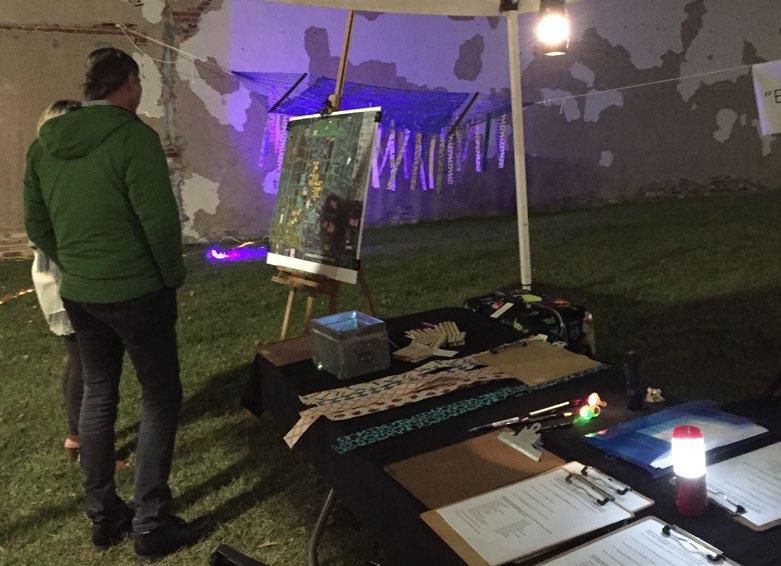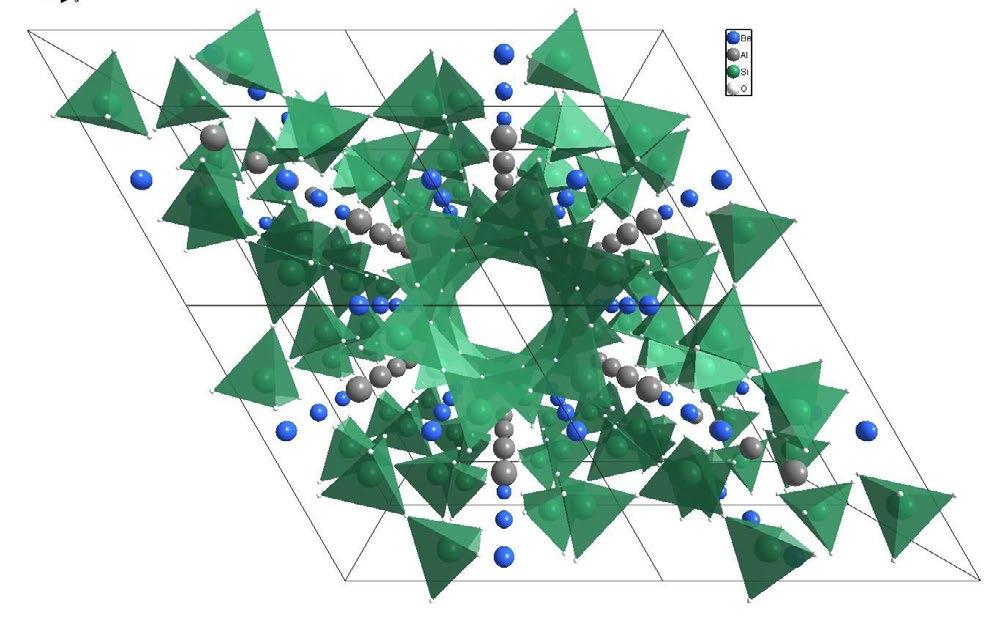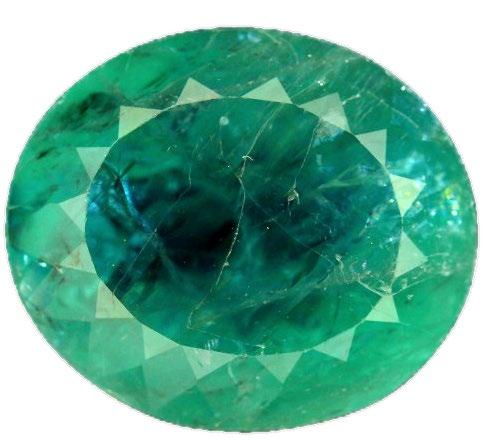
10 minute read
Community Engagement
Developer Community
With the recent growth and transformational energy of residential, commercial and mixed-use developments in the Center City, outreach to private developers has been an important aspect in understanding the potential role these projects may have in creating an art-infused Center City and implementing the Emerald Loop. Critical to implementation of the ELVP will be partnerships with developers who can integrate art into their new and existing developments. Artists can be commissioned to work with the design team or, if the project is existing, they can enhance facades, storefront windows and empty spaces in numerous ways. Developers in general agreed that murals, light art, sculpture and programming incorporated into their projects and the surrounding public realm will enhance their projects and add value to the Center City, making it a win for all.
Advertisement
West Greenville Community
Essential to the development of the Emerald Loop is the reconnection of the Center City with the diverse surrounding neighborhoods and communities that currently are not as integrated as one would expect, given their close proximity. Through meetings with a variety of stakeholders, including representatives from NC Civil, the Greenville Theater Arts Center and African American Music Trails, it became clear that enhancing and highlighting West Greenville’s cultural past, present and future, as well as providing places for that culture to thrive today, will be essential to building a stronger and more diverse community in the Center City art scene. Connections both physical, through infrastructure and social, through inclusive programming, will strengthen these bonds. Physical connections can be enhanced through design improvements to streets, sidewalks, paths and trails, as well as strategic land use and zoning. Social connections will grow with physical connections in the urban environment and also through a concerted effort to provide inviting spaces for art-making, performance and events. Shared art experience, spaces, programs and resources are critical for creating community bonds over time. As one West Greenville community activist put it, if spaces are made available, culture will happen spontaneously. This currently happens to a small extent in some locations such as the Town Common bandstand with impromptu performances. A visionary program has started with the Greenville Theater Arts Center at the historic Roxy Theater, providing both original theatrical productions and educational programs. These efforts should be supported and communicated to the broader Greenville community. The important connections between the past, present and future have been emphasized with the work of African American Music Trails, highlighting the musical legacy of Eastern North Carolina. Currently, the African American Cultural Trail Association is developing a self-guided tour to share the history of Greenville and Pitt County, with locations including Sycamore Hill Gateway Plaza and other significant places. Through a mobile app, there will be accounts from individuals along with photographs and oral histories from people who lived in historic neighborhoods and their descendants. It is hoped that sharing this cultural legacy will help ameliorate historic divisions and connect communities.

Emerald Loop Vision Team meeting with representatives of GTAC and African American Cultural Trails at the Roxy Theater The Emerald Loop Vision Team met with NC CIVIL's Jermaine McNair at the Gold Post Cafe (Jermaine shown above at the West Greenville Pop Up Market and Resource Fair, an earlier event also held at the Gold Post Cafe)


Community Visioning & Survey
Outreach Activities
The Emerald Loop Vision Plan Team set up a booth at the Evans Street Courtyard during Greenville’s November 1st, 2019 Art Walk, which coincided with a Freeboot Friday event at Five Points. In addition to posting maps of the ELVP in progress and discussing the project with passersby, two visioning exercises were offered, both aimed at hearing from people about their perceptions of and desires for art experiences in Greenville's Center City. One activity was a creative "vision cloud" exercise to gather wishes and desires for art in Greenville and use that insight to literally build a cloud. People selected a strip of patterned paper and wrote their visions on it. These strips were pinned to a suspended hammock, accumulating over the evening to form a sculptural cloud that was illuminated with color-changing light. For those who wanted to provide more detail, a more straightforward survey with a variety of both quantitative and qualitative questions was provided. From these activities as well as conversations with passersby, a wealth of ideas arose, all of which helped inform the Emerald Loop Vision Plan.
What is something special about Greenville?
Through the responses to this question it has become explicitly clear that the residents of Greenville recognize the value and proliferation of their homegrown talent and the potency of the city’s history. One respondent made a point that “downtown was built by people who held wealth and those who did not” and emphasized the importance of honoring and celebrating all ends of the socio-economic spectrum through the arts. Another theme in the responses to this question that rose to the top was the value of Greenville’s connection to the Tar River. Though the ways in which the city relates to the river may have shifted over time, there is no doubt that the waters hold a special place in the hearts of the residents. Some residents celebrate the wildlife that shares in the attachment to the river while others bemoan the lack of easy access to the water. Using the ELVP to reinforce connections to the inherent natural beauty of the river will capitalize on one of Greenville’s best assets.


What are some of the most interesting, or memorable places in the Center City?
A vast majority of respondents placed great importance on the art spaces of Greenville – including studios, galleries and the art museum – as well as events that change a place through thematic activation. Closely following those responses and at times directly alongside them, were responses acknowledging the value of Greenville’s open spaces. The scales ranged from Town Common and the Greenway system to alleyways ready to become more formally realized parklets. There is a clear desire to engage with the city through the outdoors. Another aspect of Greenville’s Center City that respondents appreciate are places of commerce and social interaction. Breweries and restaurants show up with notable regularity.
“Art everywhere how cool would that be”
What would you like to see change in the Center City?
In general, people are happy with what is already available. Instead of looking to remove anything, residents hope to augment the Center City experience through additions of a variety of things. At the top of the list is art and color. People want to breathe life and energy into the Center City and feel that murals, especially bright ones, can help to do so. Others want to see art used to activate under utilized spaces, such as empty storefronts. Programs that bring artists into such a space and allow them to use the place as a studio can generate interest in the neighborhood, the property and the artist’s work - benefitting a wide gamut of stakeholders. Others made a call for more diversity in culinary offerings. Integrating a larger variety of food options helps to cultivate a feeling of relevancy to a comparably large array of peoples and can foster unity through the sharing of cultural customs and traditions. The value of food should not be overlooked in the bringing together of people.


What is your favorite artwork or art event in Greenville, or other places?
There was no discernible pattern in this collection of answers, suggesting that there is a need for a broad range of future works and events to appeal to the varied tastes of Greenville. People love the existing sculptures and all of the events – from the Art Walk to Pirate Fest to smaller music events and the rotating mural on Starlight Cafe.
“MORE green parkland LESS concrete parking”


What types of art works or experiences would you be most interested in seeing or attending in the Center City?
The preferred art experiences (in order) are: murals, eco art, interactive art & water features, open studios, outdoor films, performances and concerts, art lighting, sculpture walks, maker spaces, gateways, iconic sculpture and plazas. A majority of respondents wish to see more murals adorning the walls of Greenville's Center City. Others see value in architectural artistic facade treatments and lighting, while some are interested in moving off the walls and wish to see paint liven up the parking lots and crosswalks around town.
These passive art activations are contrasted by interest in more active types of art and events including nature walks, interactive water features, open studios, outdoor films and musical performances and an arts and crafts marketplace. A very general trend is that older respondents have more interest in temporary programming and events, whereas younger respondents would like to see more permanent art.

What time of day or night would you most likely be in Center City?
We received a full range of responses to this question, making it clear that the Center City is an active place throughout a 24-hour cycle. A majority of responses did indicate a preference for visiting in the early evening; therefore, experiences being available from 5-9 PM would ensure the largest number of participants. Of the daytime respondents, few gave any indication they were there for anything other than work. This indicates that the middle of the day is a prime time to target activation efforts through additional passive and active programming.

VISION FOR ART
Conceptual Framework: An Emerald City
Emerald Vision
Greenville, as the Pitt County seat and a destination for education, health care, business and culture, is the gem or “emerald” of Eastern North Carolina. Greenville and its surrounding landscape is verdant with agricultural heritage and natural beauty along the Tar River.
The color green evokes growth, renewal and health. It symbolizes good luck and fertility. Emeralds, the North Carolina state gemstone, are believed to have the power to improve both memory and intelligence and transform the negative to positive.
Green Heart
The Emerald Loop will represent and exhibit the “green heart” of Greenville. The emerald concept should be integral to the mind-set of an evolving Center City.
Inserting the concept of “emerald” into Greenville's Center City is a fortuitous vision of community growing and renewing in a fertile, innovative urban environment that generates cultural experience looking both forward and backward.
Imaginations
The Emerald Loop, like the “Emerald City” of L. Frank Baum’s The Wonderful Wizard of Oz, is in part an idealistic, utopian image of a real place. While the wizard passes out glasses with green lenses to help with the visualization, the message is, imagine it, will your way to it and it will become real. The community of Greenville, in engaging with the vision, will propel the growth and realization of their city.
Imagined cities become real cities.
Emeralds mined in North Carolina



Molecular structure of hexagonal emerald crystals, composed of tetrahedrons (4-sided equilateral triangles)









